車牌識別項目基于百度智能云平臺,旨在利用其強大的OCR服務實現車牌號碼的自動識別。選擇百度智能云的原因是其高效的API接口和穩定的服務質量,能夠幫助開發者快速實現車牌識別應用。
這個開源項目使用攝像頭捕捉圖像后,通過集成百度OCR服務的API,能夠輕松識別圖像中的車牌號碼,并將識別結果實時顯示在Qt界面上。
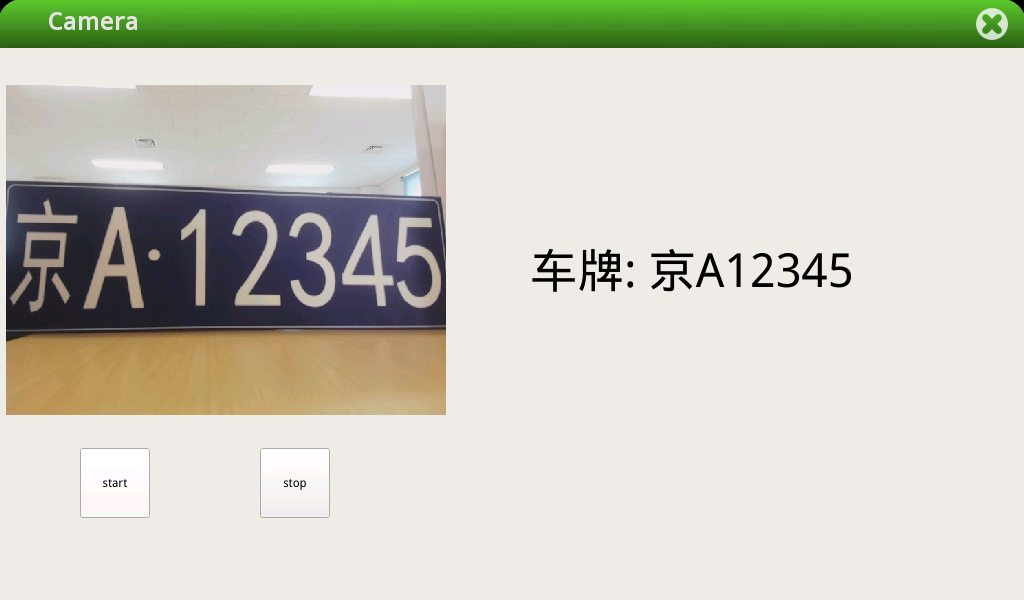
功能特性
1、圖片處理和OCR識別:使用百度OCR服務,能夠通過API輕松識別圖片中的車牌號碼。
2、攝像頭實時采集圖像并保存:使用Qt設計了直觀的用戶界面,控制USB攝像頭的打開、關閉以及實時顯示攝像頭捕獲的視頻流,并將采集到的視頻流保存為圖像。
環境說明
1、開發環境操作系統:Ubuntu18.04 64位版
2、交叉編譯工具鏈:arm-poky-linux-gnueabi-gcc 5.3.0
3、開發板使用Bootloader版本:u-boot-2016.03
4、開發板內核版本:linux-4.1.155、開發板移植QT版本:qt5.6.2
圖片處理和OCR識別
百度智能云網址:cloud.baidu.com
本次車牌識別的方案是通過百度智能云平臺進行實現的。首先進入百度智能云網頁- >選擇文字識別 - > 車牌識別。
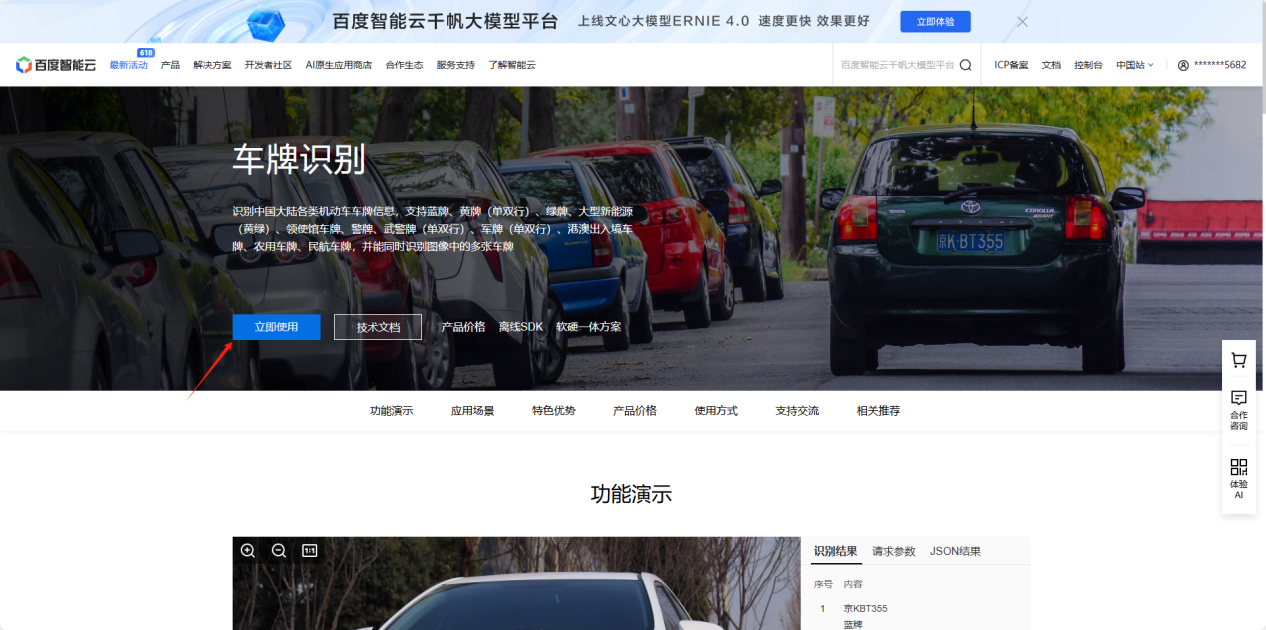
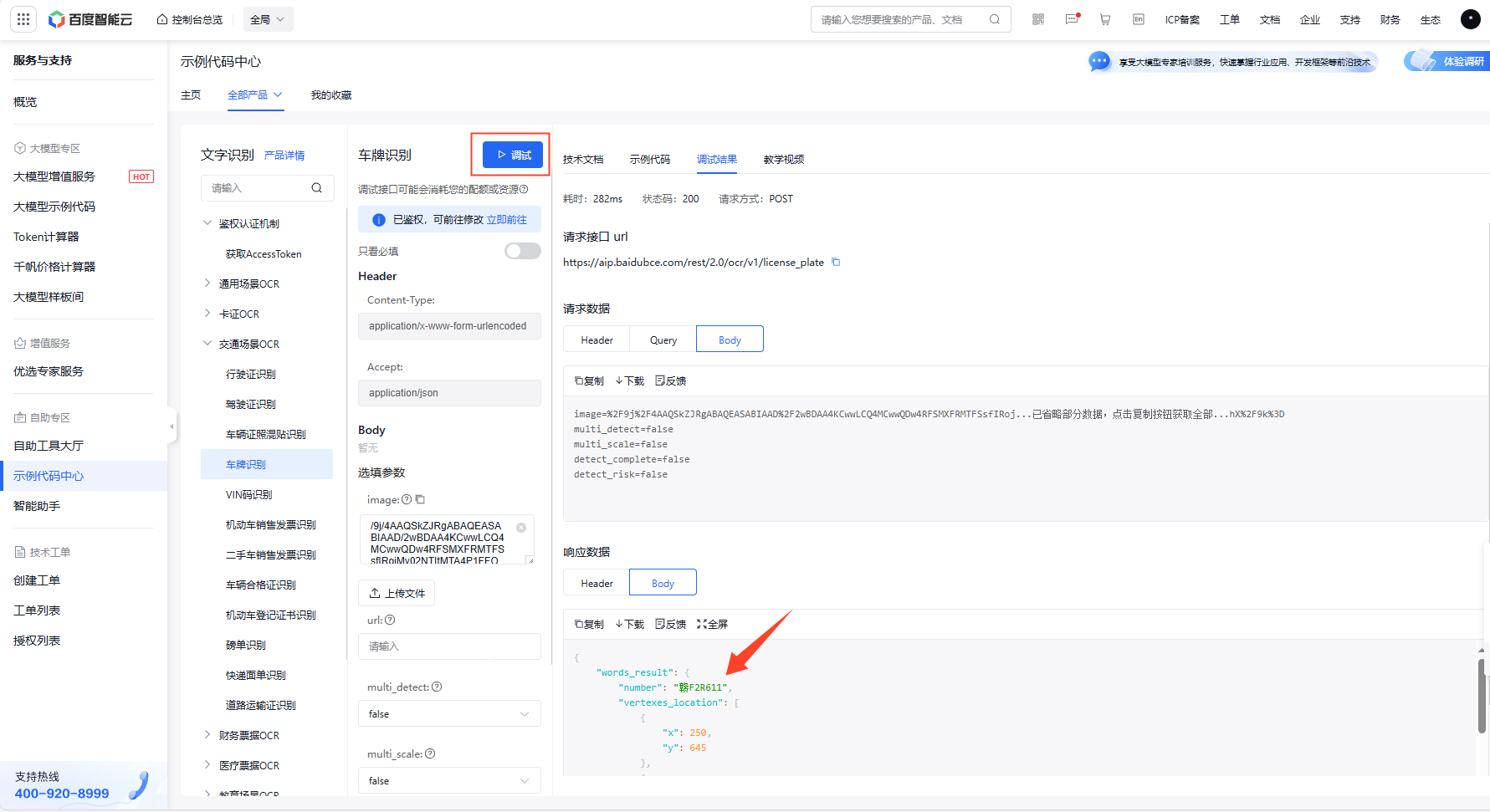
進入車牌識別頁面之后可通過閱讀技術文檔來學習車牌識別的使用方法。
在線識別車牌圖片
在本地實現之前可通過平臺提供的在線驗證方法進行驗證,如下圖,需要在旁邊輸入一張車牌圖片的base64 編碼的字符串或者選擇上傳一張車牌圖片,即可進行在線識別。視頻教程:cloud.baidu.com/video-center/video/741

識別本地車牌圖片
本地實現車牌識別的方法需要將識別代碼拷貝到本地,并需要實現一個將圖片轉換為base64編碼的函數。需要輸入自己的access_token(通過閱讀文檔可知怎么獲取)。
#include
#include
#include
#include
#include
#include
#include #include #include #include #include ? inline size_t onWriteData(void * buffer, size_t size, size_t nmemb, void * userp) { std::string * str = dynamic_cast((std::string *)userp);
str->append((char *)buffer, size * nmemb); return nmemb;
} ? std::string getFileBase64Content(const char * path, bool urlencoded=false) { const std::string base64_chars = "ABCDEFGHIJKLMNOPQRSTUVWXYZ" "abcdefghijklmnopqrstuvwxyz" "0123456789+/"; std::string ret;
int i = 0; int j = 0;
unsigned char char_array_3[3]; unsigned char char_array_4[4]; unsigned int bufferSize = 1024; unsigned char buffer[bufferSize]; std::ifstream file_read; file_read.open(path, std::ios::binary);
while (!file_read.eof()){ file_read.read((char *) buffer, bufferSize * sizeof(char));
int num = file_read.gcount(); int m = 0;
while (num--){ char_array_3[i++] = buffer[m++]; if(i == 3){ char_array_4[0] = (char_array_3[0] & 0xfc) >> 2;
char_array_4[1] = ((char_array_3[0] & 0x03) << 4) + ((char_array_3[1] & 0xf0) >> 4); char_array_4[2] = ((char_array_3[1] & 0x0f) << 2) + ((char_array_3[2] & 0xc0) >> 6); char_array_4[3] = char_array_3[2] & 0x3f;
for(i = 0; (i <4) ; i++) ret += base64_chars[char_array_4[i]]; i = 0;
} } } file_read.close(); if(i){ for(j = i; j < 3; j++) char_array_3[j] = '\0'; char_array_4[0] = (char_array_3[0] & 0xfc) >> 2; char_array_4[1] = ((char_array_3[0] & 0x03) << 4) + ((char_array_3[1] & 0xf0) >> 4); char_array_4[2] = ((char_array_3[1] & 0x0f) << 2) + ((char_array_3[2] & 0xc0) >> 6); char_array_4[3] = char_array_3[2] & 0x3f;
for(j = 0; (j < i + 1); j++) ret += base64_chars[char_array_4[j]]; while((i++ < 3)) ret += '='; } if (urlencoded) ret = curl_escape(ret.c_str(), ret.length());
return ret; } std::string performCurlRequest(const char *pic_path, const std::string &token) { std::string result;
char *web_curl = nullptr;
CURL *curl = curl_easy_init(); CURLcode res; if (!asprintf(&web_curl, "https://aip.baidubce.com/rest/2.0/ocr/v1/license_plate?access_token=%s", token.c_str())) { perror("asprintf error"); } curl_easy_setopt(curl, CURLOPT_CUSTOMREQUEST, "POST");
curl_easy_setopt(curl, CURLOPT_URL, web_curl); curl_easy_setopt(curl, CURLOPT_FOLLOWLOCATION, 1L); curl_easy_setopt(curl, CURLOPT_DEFAULT_PROTOCOL, "https"); ? curl_easy_setopt(curl, CURLOPT_SSL_VERIFYPEER, 0L); curl_easy_setopt(curl, CURLOPT_SSL_VERIFYHOST, 0L); ? struct curl_slist *headers = NULL; headers = curl_slist_append(headers, "Content-Type: application/x-www-form-urlencoded");
headers = curl_slist_append(headers, "Accept: application/json"); curl_easy_setopt(curl, CURLOPT_HTTPHEADER, headers); std::string base64_image = getFileBase64Content(pic_path, true); std::string post_data = "image=" + base64_image + "&multi_detect=false&multi_scale=false";
curl_easy_setopt(curl, CURLOPT_POSTFIELDS, post_data.c_str()); curl_easy_setopt(curl, CURLOPT_WRITEDATA, &result); curl_easy_setopt(curl, CURLOPT_WRITEFUNCTION, onWriteData); ? curl_easy_setopt(curl, CURLOPT_SSL_VERIFYPEER, false); curl_easy_setopt(curl, CURLOPT_SSL_VERIFYHOST, 0L);
if(curl_easy_perform(curl) != CURLE_OK) fprintf(stderr, "Curl request failed: %s\n", curl_easy_strerror(res)); curl_easy_cleanup(curl); free(web_curl); return result;
} int main(int argc, char *argv[]) { std::string access_token = "24.d69c300e601a1d2e3f735d916d45eb5a.2592000.1724636199.282335-99367601"; //填自己的access_tocken std::string result;
std::string car_number; ? result = performCurlRequest("/home/root/num/1.jpg", access_token); //存放圖片的路徑 ? std::string json = result; std::regex pattern(""number":"(.*?)""); std::smatch match; if (std::regex_search(json, match, pattern)) { car_number = match[1].str(); std::cout << "read car number is: " << car_number << std::endl; } }
依賴庫編譯
編譯車牌識別的應用需要依賴Curl庫、OpenSSL庫、OpenCv庫、JsonCPP庫。詳細的依賴庫安裝步驟請參考以下鏈接:
bbs.elfboard.com/forum.php?mod=viewthread&tid=496&extra=page%3D1
bbs.elfboard.com/forum.php?mod=viewthread&tid=495&extra=page%3D1
bbs.elfboard.com/forum.php?mod=viewthread&tid=497&extra=page%3D1
bbs.elfboard.com/forum.php?mod=viewthread&tid=498&extra=page%3D1
應用編譯
elf@ubuntu:~/work$ . /opt/fsl-imx-x11/4.1.15-2.0.0/environment-setup-cortexa7hf-neon-poky-linux-gnueabi elf@ubuntu:~/work$ $CXX demoCar.cpp -o demoCar -I /home/elf/work/curl-7.71.1/install/include/ -I /home/elf/work/jsoncpp-1.9.5/install/include/ -I /home/elf/work/opencv-3.4.1/install/include/ -std=c++11 -L /home/elf/work/curl-7.71.1/install/lib/ -L /home/elf/work/jsoncpp-1.9.5/install/lib/ -L /home/elf/work/opencv-3.4.1/install/lib/ -lopencv_core -lopencv_highgui -lopencv_imgproc -lopencv_videoio -lopencv_imgcodecs -lcurl
編譯完成將文件通過scp拷貝到ELF 1開發板運行即可,這樣就可以將本地的車牌圖片通過HTTPS發送到百度智能云進行識別,并將識別結果返回。
攝像頭實時采集圖像并保存
程序設計
在前面一個章節實現了對本地車牌圖片的識別,下面來介紹如何通過攝像頭進行車牌識別,采用USB攝像頭進行識別,程序設計如下圖所示。
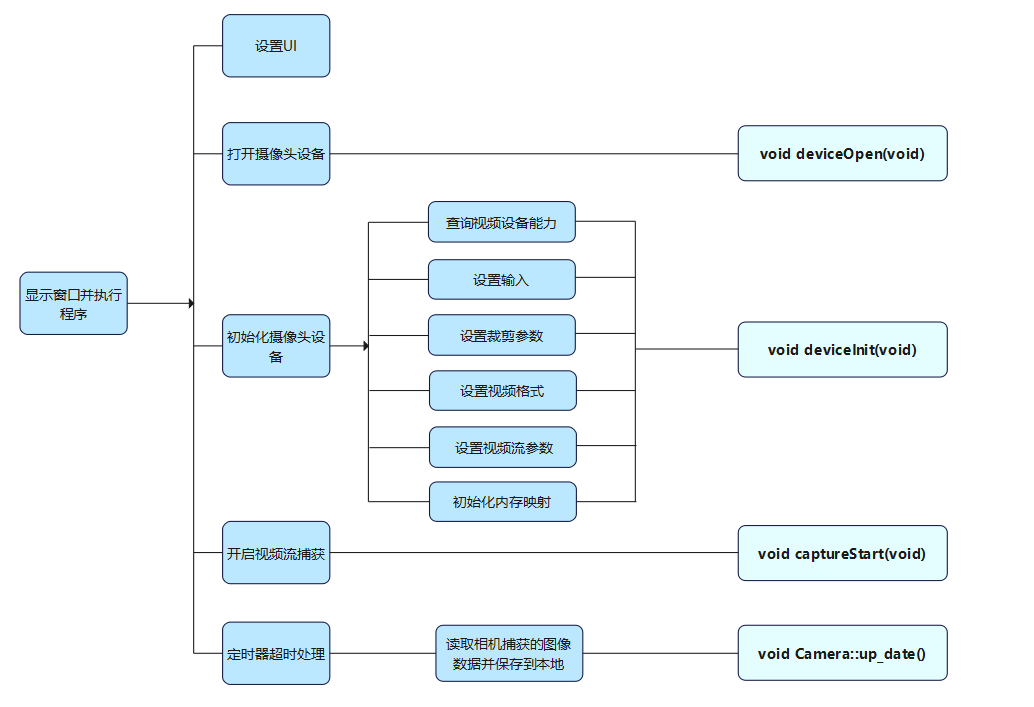
主函數的實現main.cpp
int main(int argc, char *argv[]) { QApplication a(argc, argv); Camera w; w.setWindowFlags(w.windowFlags()& ~Qt::WindowMaximizeButtonHint& ~Qt::WindowMinimizeButtonHint ); w.showMaximized(); w.show(); return a.exec(); }
設置UI
ui->setupUi(this); timer = new QTimer; QDesktopWidget* desktopWidget = QApplication::desktop(); QRect screenRect = desktopWidget->screenGeometry(); qDebug("screen.width = %d , screen.height = %d",screenRect.width(),screenRect.height());
this->imageWidget = new ImageWidget(this);
this->imageWidget->setBackgroundRole(QPalette::Dark); this->imageWidget->setSizePolicy(QSizePolicy::Ignored, QSizePolicy::Ignored); this->imageWidget->setObjectName(QString::fromUtf8("imageWidget"));
if(screenRect.width()==800) { ui->pbt_start->setGeometry(60,300,70,50); ui->pbt_stop->setGeometry(190,300,70,50); this->imageWidget->setGeometry(QRect(5, 30, 350, 250)); } else if(screenRect.width()>800) { ui->pbt_start->setGeometry(80,400,70,70); ui->pbt_stop->setGeometry(260,400,70,70);
this->imageWidget->setGeometry(QRect(6, 37, 500, 330)); }
打開攝像頭設備
void deviceOpen(void) { fd = open(deviceName, O_RDWR | O_NONBLOCK, 0); if (-1 == fd) { QMessageBox::about(NULL, "About", "camera open error"); exit(EXIT_FAILURE); } }
初始化攝像頭設備
void deviceInit(void) { struct v4l2_capability cap; struct v4l2_cropcap cropcap; struct v4l2_crop crop; struct v4l2_format fmt; struct v4l2_streamparm sparm; unsigned int min;
if (-1 == xioctl(fd, VIDIOC_QUERYCAP, &cap)) { if (EINVAL == errno) { QMessageBox::about(NULL,"Information"," no V4L2 device");
exit(EXIT_FAILURE); } else { errno_exit("VIDIOC_QUERYCAP");
} } if (!(cap.capabilities & V4L2_CAP_VIDEO_CAPTURE)) { QMessageBox::about(NULL,"Information"," no video capture device"); exit(EXIT_FAILURE); } struct v4l2_input input; input.index = 0; if ( ioctl(fd, VIDIOC_ENUMINPUT, &input) != 0) { QMessageBox::about(NULL,"Information","set input error");
exit(0); }
if ((ioctl(fd, VIDIOC_S_INPUT, &input)) < 0) { QMessageBox::about(NULL,"Information","set s_input error");?
exit(0); } CLEAR(cropcap); cropcap.type = V4L2_BUF_TYPE_VIDEO_CAPTURE; if (0 == xioctl(fd, VIDIOC_CROPCAP, &cropcap)) { crop.type = V4L2_BUF_TYPE_VIDEO_CAPTURE; crop.c.top = 0; crop.c.left = 0; crop.c.height = 720; crop.c.width = 1280; if (-1 == xioctl(fd, VIDIOC_S_CROP, &crop)) { switch (errno) { case EINVAL: break; default: break; } } } CLEAR (fmt);
// v4l2_format fmt.type = V4L2_BUF_TYPE_VIDEO_CAPTURE; fmt.fmt.pix.width = width; fmt.fmt.pix.height = height; fmt.fmt.pix.pixelformat = V4L2_PIX_FMT_YUYV; fmt.fmt.pix.field = V4L2_FIELD_ANY; if (-1 == xioctl(fd, VIDIOC_S_FMT, &fmt)) errno_exit("VIDIOC_S_FMT");
/* Note VIDIOC_S_FMT may change width and height.*/ if (width != fmt.fmt.pix.width) { width = fmt.fmt.pix.width; //fprintf(stderr,"Image width set to %i by device %s.\n",width,deviceName); } if (height != fmt.fmt.pix.height) { height = fmt.fmt.pix.height; //fprintf(stderr,"Image height set to %i by device %s.\n",height,deviceName); } /*Buggy driver paranoia. */ min = fmt.fmt.pix.width * 2; if (fmt.fmt.pix.bytesperline < min) fmt.fmt.pix.bytesperline = min;?
min = fmt.fmt.pix.bytesperline * fmt.fmt.pix.height; if (fmt.fmt.pix.sizeimage < min) fmt.fmt.pix.sizeimage = min; CLEAR (sparm); sparm.type = V4L2_BUF_TYPE_VIDEO_CAPTURE; sparm.parm.capture.capturemode = 0; sparm.parm.capture.timeperframe.numerator = 1; sparm.parm.capture.timeperframe.denominator = 30; if(xioctl(fd,VIDIOC_S_PARM,&sparm) < 0){ errno_exit("cam s parm"); // exit(1); } mmapInit(); }
開啟視頻流捕獲
void captureStart(void) { unsigned int i; enum v4l2_buf_type type; for (i = 0; i < n_buffers; ++i) { struct v4l2_buffer buf; CLEAR (buf); buf.type = V4L2_BUF_TYPE_VIDEO_CAPTURE; buf.memory = V4L2_MEMORY_MMAP; buf.index = i; if (-1 == xioctl(fd, VIDIOC_QBUF, &buf)) errno_exit("VIDIOC_QBUF"); } type = V4L2_BUF_TYPE_VIDEO_CAPTURE; if (-1 == xioctl(fd, VIDIOC_STREAMON, &type)) errno_exit("VIDIOC_STREAMON"); }
超時處理
void Camera::up_date() { unsigned char image_buf[921600+54]; frameRead(image_buf); this->imageWidget->setPixmap(image_buf); }
應用編譯及測試
編譯
elf@ubuntu:~/work/camera-demo$ . /opt/fsl-imx-x11/4.1.15-2.0.0/environment-setup-cortexa7hf-neon-poky-linux-gnueabi elf@ubuntu:~/work/camera-demo$ qmake elf@ubuntu:~/work/camera-demo$ make
拷貝camera-demo到ELF 1開發板的/home/root路徑下,運行測試
root@ELF1:~# cp /run/media/sda1/camera-demo ./ root@ELF1:~# chmod 777 camera-demo root@ELF1:~# export DISPLAY=:0.0 root@ELF1:~# ./camera-demo
點擊start按鈕之后,使用ls num路徑下查看會有攝像頭拍攝的圖片。液晶屏上會實時預覽攝像頭拍到的圖像,如下圖所示:
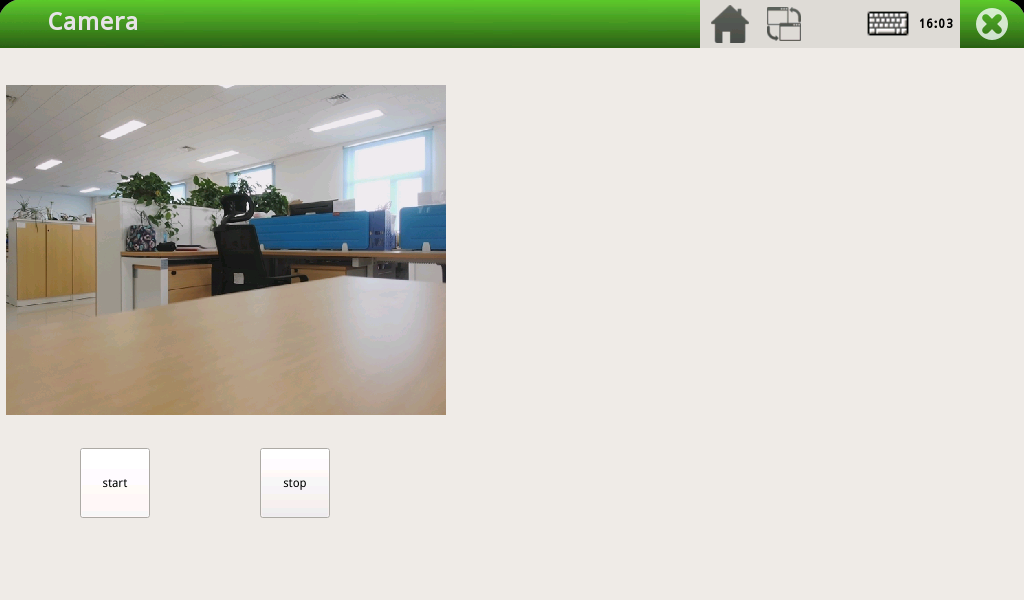
在這里就可以和前面車牌識別結合起來了,比如攝像頭里面的畫面是一張車牌信息,通過截取攝像頭中的實時畫面到本地,然后上傳到百度智能云的后臺進行識別,至此就完成了通過攝像頭進行車牌識別的過程。
項目測試
在此基礎上再次完善應用,識別車牌的應用將識別到的車牌信息保存到文本中,基于攝像頭的應用讀取文檔中的車牌信息顯示在Qt界面中。
1、確保開發板已連接USB攝像頭和屏幕
2、設置Wi-Fi連接
root@ELF1:~# elf1_cmd_wifi.sh -i 8723 -s 賬號 -p 密碼
執行應用
root@ELF1:~# ./camera-demo & root@ELF1:~# ./demoCar
單擊“start”按鈕,識別結果如下圖所示

-
單片機
+關注
關注
6039文章
44588瀏覽量
636742 -
嵌入式
+關注
關注
5087文章
19150瀏覽量
306343 -
開發板
+關注
關注
25文章
5086瀏覽量
97781 -
開源代碼
+關注
關注
0文章
36瀏覽量
2995
發布評論請先 登錄
相關推薦
【MYD-Y6ULX申請】基于攝像頭的人臉識別項目
【HarmonyOS HiSpark AI Camera】智能充電站項目-車牌識別、刷臉充電、空閑車位
三步就能在OpenHarmony中實現車牌識別
三步就能在OpenHarmony中實現車牌識別
基于OpenCV開源庫開發的在OpenHarmony中實現車牌識別
Arduino Nano 33 BLE Sense的語音識別項目

眼神科技獨家中標渤海銀行人臉識別項目!
ElfBoard開源項目|“智慧教室”開源項目技術文檔

ElfBoard開源項目|“智慧光伏”開源項目技術文檔

【實戰】人工智能0基礎入門:基于Python+OpenCV的車牌識別項目(課程+平臺實踐)

ElfBoard開源項目|百度智能云平臺的人臉識別項目





 ElfBoard開源項目|車牌識別項目技術文檔
ElfBoard開源項目|車牌識別項目技術文檔












評論